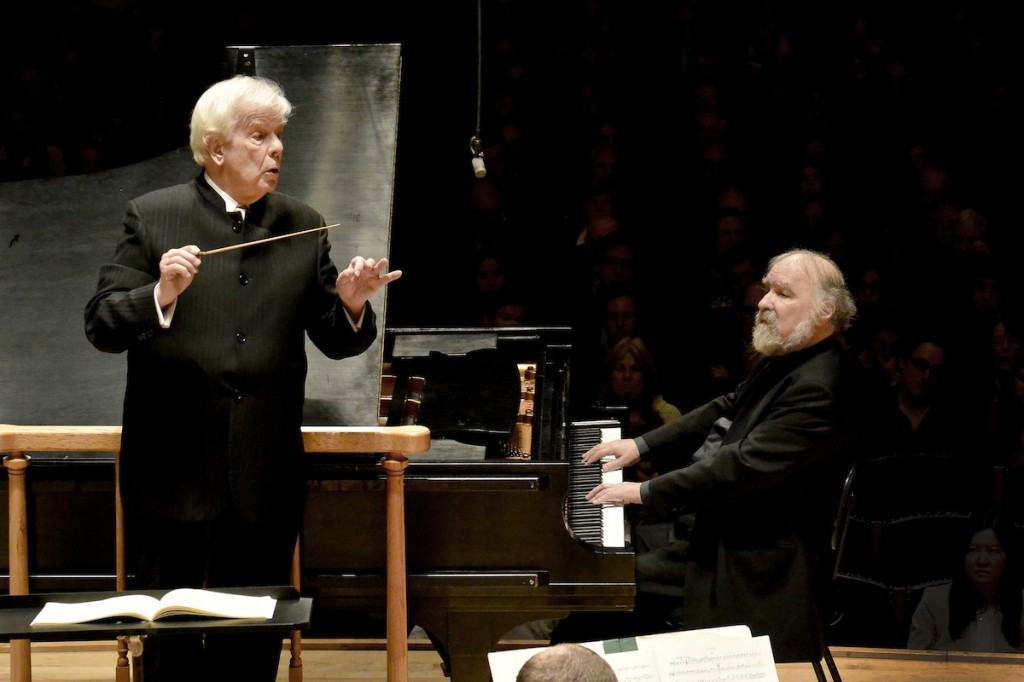Dohnányi, Lupu and BSO contrast modest Mozart with bold Bruckner

Christoph von Dohnányi conducts the BSO Thursday night with Radu Lupu as soloist in Mozart’s Piano Concerto No 23. Photo: Stu Rosner.
Whether you like your music intimate or heaven-storming, Christoph von Dohnányi, Radu Lupu and the Boston Symphony Orchestra had something for you on Thursday night.
Lupu’s introspective solo playing set the tone for a small gathering of musicians in Mozart’s Piano Concerto No. 23 in A major, K. 488. Then, after the intermission, conductor Dohnányi returned to rattle the statues of Symphony Hall with a bold, brass-rich performance of Bruckner’s Symphony No. 4 in E-flat major (“Romantic”).
Although no particular fuss was made about it, one noticed in Lupu’s program biography that this concert marked the 35th anniversary (plus a couple of months) of the Romanian pianist’s first appearance with the BSO, playing the same Mozart concerto.
His interpretation may have mellowed over the years, since the Lupu of 2013 was a picture of serenity at the instrument, sitting almost completely still and gently inflecting the melodies and purling scales of this predominantly lyrical concerto.
With its small orchestra, K. 488 is considered to have more chamber-music character than other Mozart concertos. Especially during the finale, Lupu could be seen not just watching Dohnányi on the podium as he played, but turning his head upstage to look at the musicians in the orchestra. There was the feeling of an intimate conversation, with the audience invited to listen in.
Like many conversations, this one got off to a slow start, as Dohnányi led a rather vague statement of Mozart’s graceful themes. Lupu’s answer at the piano seemed hardly more distinct—or else one’s ear hadn’t quite adjusted yet to his nonassertive approach.
By the development section, however, Lupu was hitting his stride with crisp dotted rhythms, and the original themes returned in better focus for both orchestra and soloist, the latter contributing especially nice touches of voicing and counterpoint. The pianist’s solo cadenza, traditionally an occasion for display, came off here as more whimsical and meditative than showy.
The D minor Adagio, delivered in hushed tones that only increased its pathos, was distinguished by the pianist’s quiet yet singing tone and perfect realization of the gently rocking siciliano rhythm, and by exquisitely sensitive wind solos that crept onto the scene with their soft lamentations.
The closing Allegro assai gave the pianist a lot to do, but even here Lupu seemed more interested in the play of Mozart’s tone colors and darting effects than in showing off his technique. Ultimately, however, the movement’s infectious rhythms took over, lifting pianist and orchestra together to a cheerful, satisfying finish.
The orchestra’s size appeared to double after intermission, as the stage filled with players from wall to wall for the Bruckner symphony. As the composer surely knew, that sight by itself was enough to create enormous suspense at the work’s opening, with the strings trembling ultra-pianissimo and a single horn intoning the slow notes of the theme.
During this and the symphony’s many other long soft passages, Dohnányi kept the players intensely focused, so that the listener never forgot the latent power onstage. And when at last the crescendos began to build, Dohnányi managed them expertly, never releasing the tension until the long-awaited fortissimo resolution.
The Andante second movement was indeed “like an Allegretto” as Bruckner marked it, animated by its gently skipping rhythm. In an especially gratifying passage, a theme for rich-toned violas over pizzicato strings was taken up in turn by finely blended woodwinds, then lush strings, as Dohnányi made the most of a crescendo achieved by instrumentation, not just playing louder.
The conductor gave the Scherzo’s galloping triplets, the composer’s “Romantic” tribute to forests and the hunt, the manic edge of a real chase to the death. A bit of that rhythmic precision would have helped the trio’s swoopy ländler dance create a contrast, but that moment of laxness was soon forgotten when the scherzo returned, even more scintillating than the first time.
The Scherzo was only the most obvious example of the high level of execution that prevailed throughout the symphony, with one conspicuous exception. The extreme difficulty of starting a pianissimo horn note accurately was all too evident throughout the evening, as Bruckner repeatedly called for very soft horn attacks, and those notes repeatedly cracked Thursday night. When principal hornist James Sommerville stood for his bow at the end, the wave of applause in response seemed like bucking up an old friend after a hard night.
The Scherzo’s militant mood continued as the last movement began, but soon gave way to the second theme in lush strings with pretty woodwind highlights. And so went all of this highly episodic finale—in music playful or fervent, sensuous or aggressive, and always unpredictable, Dohnányi’s performance could be counted on for clarity, balance, suspense, flawless ensemble, and massive sound in the climaxes. The statues stayed on their pedestals, but barely.
The program will be repeated 8 p.m. Saturday. bso.org; 617-266-1200.
Posted in Performances




